ASUS F2A85-V Pro Review: A Look at FM2 with A85X
by Ian Cutress on October 10, 2012 11:20 AM EST- Posted in
- Motherboards
- Asus
- Trinity
- FM2
- A85X
ASUS F2A85-V Pro Software
The software package provided by ASUS is often cited by us as one of the best software packages with a motherboard, and this is still true on the FM2 socket and Trinity processors. The install CD is the same platform used by ASUS on their Intel products, with one menu for software and another for utilities. Each of these menus allows for a one-click ‘Install-All’ option, and clicking through allows users to deselect certain options that may not be relevant to them.
Within the software package, Daemon Tools Pro was installed by default. I have used Daemon Tools for years – it is a great piece of software for mounting disk images.
The main software package revolves around ASUS’ AI Suite. This software acts as an interface for the smaller additional programs that ASUS create for use on the motherboard.
ASUS AI Suite
The main bar of AI Suite splits the sub-programs up into groups, with two of the major utilities having their own buttons. In the case with the F2A85-V Pro this is the Auto Tuning option for overclocking and the Remote Go utility for media and file organization over network connections to tablets and smartphones. We will go through these in turn.
TurboV Evo
TurboV Evo is the operating system based overclocking tool provided. It allows for changes of all the important voltages and frequencies onboard, as well as providing the Auto Tuning options for ‘Fast’ and ‘Extreme’ overclock settings. I usually find TurboV Evo a good bit of kit when overclock testing, though I would like to put in some values by numbers rather than having to fiddle with sliders all the time.
DIGI+ Power Control
In order to give users better control over the power delivery, ASUS implements their DIGI+ Power Control on the FM2 boards as well. There are fewer options here than on some of their higher end Intel board offerings, but if a user wants to give more current capabilities or adjust load line calibrations through the OS for overclocks, the options are here for both the CPU/APU and the DRAM.
In a similar vein, we also have the EPU (Energy Processing Unit) menu and settings, designed to adjust and power gate different parts of the motherboard to save energy.
Fan Xpert 2
ASUS are well known in the motherboard space for using better fan controllers that the rest of the motherboard industry – typically one per fan header which is configurable within the BIOS and in software. The beauty of these fan headers lie in their independent control – the system has access to the RPM output and can adjust the speed on the fly. Pair that up with some software that actually can manipulate such a system and we have a nice fan configuration. The software behind this is Fan Xpert 2 – bundled as part of AI Suite, it will test all the fans in the system and provide RPM vs. Power applied graphs (as this relationship is rarely linear). This allows users to adjust the temperature/RPM curves as required – the only thing missing is the ability to apply hysteresis.
USB 3.0 Boost
As part of the ASUS methodology, we have onboard an ASMedia controller which can take advantage of the most up to date USB 3.0 transfer protocols. By attaching a compatible USB 3.0 device, and a click of the USB 3.0 Boost interface, the software will apply a driver over the standard ASMedia driver in order to enforce these under the hood commands. As we have shown in previous reviews, this affords a nice bump in the speeds provided at low transfer size workloads, making a USB device more tenable for everyday random access use rather than just storage. USB 3.0 Boost can also apply a modified driver to the chipset USB 3.0 ports for a similar boost using BOT protocols rather than UASP. (Note, this should become moot for Windows 8, where UASP will be a part of the standard driver package.)
Network iControl
For the past couple of years it has been clear that users in the motherboard industry would prefer the ability to manipulate the network ports onboard their system. While doing some epic downloading while playing a twitch FPS online is a little bit of an odd combination, using software tools in the OS to manage the priority of these programs is never a bad thing. On the ASUS side this comes in the form of Network iControl, and within this software the user can adjust the software that uses the Ethernet connections and rank them in order of priority. Alternatively the system can be left on automatic, and the program will use a series of pre-defined rules to prioritize a lot of the well known programs that typically rely on low-latency throughput.
Elsewhere in AI Suite we have advanced charging software in the form of AI Charger+ and USB Charger which will manipulate the current output of specific USB ports if the appropriate device is connected. This will help greatly with charging devices, using up to 1.5A rather than 300mA. I have been asked to test this feature in future reviews, and when I have an accurate setup I will start to test these charging features. Specifically AI Charger+ is for Apple products, and USB Charger is for other devices (Kindles, smartphones et al.).
ASUS also use their USB BIOS Flashback software here, allowing users to update the BIOS without having a CPU, Memory or VGA connected. This is a feature that helps protect the product in case new CPUs are released and microcode updates are needed. If a user buys a board that is not compatible with their processor, in the past an older processor had to be found in order to update the BIOS. This is no longer the case with USB BIOS Flashback.


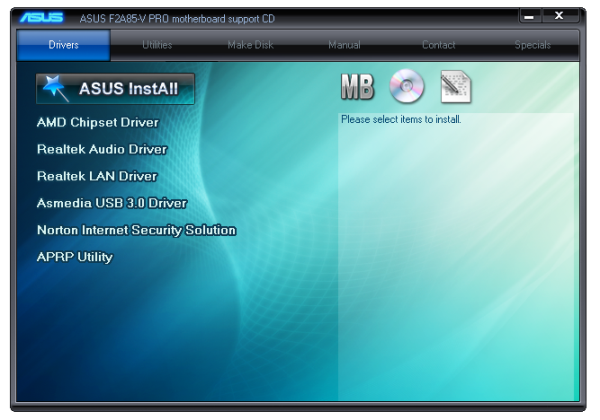
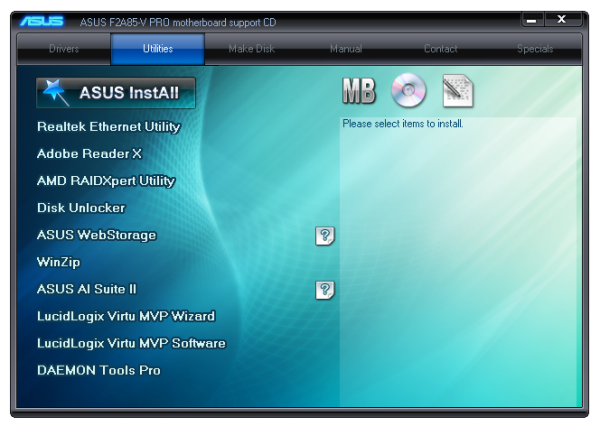

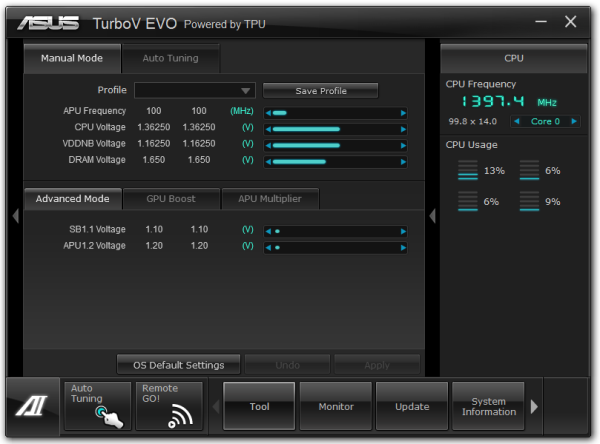
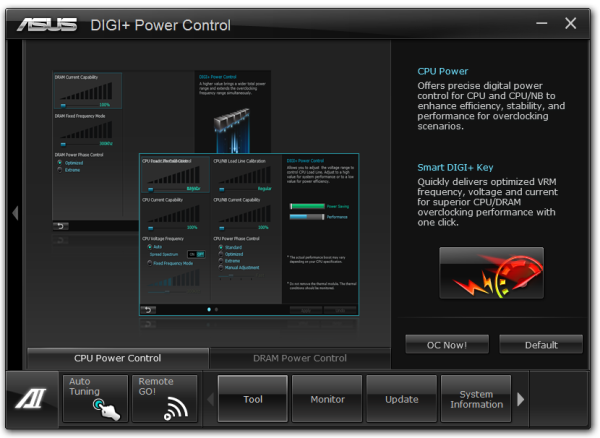
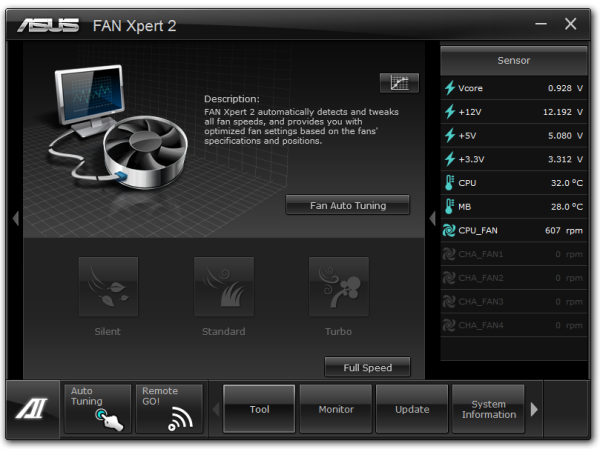
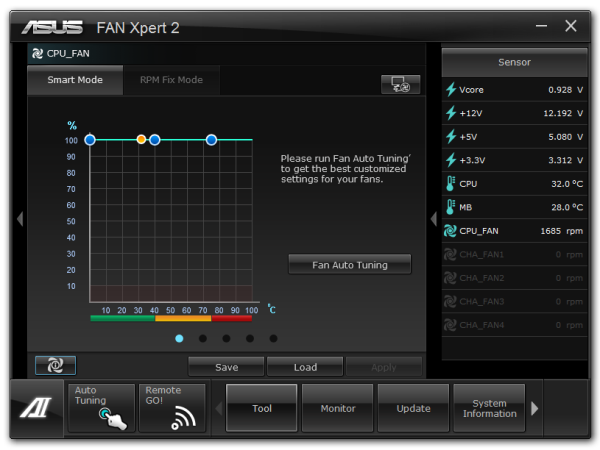
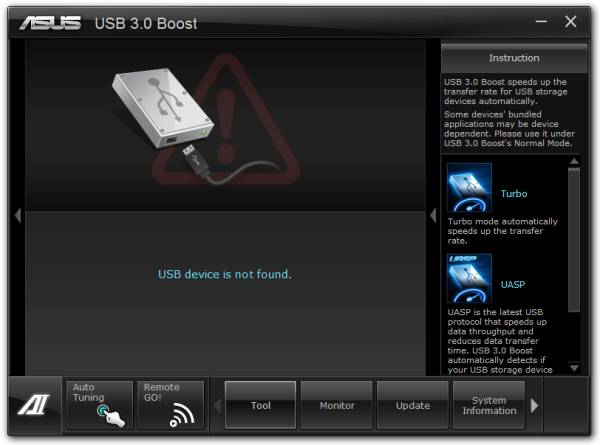














66 Comments
View All Comments
Mugur - Thursday, October 11, 2012 - link
File server - unchecked. Can't seem to find any board with 8 SATA, all are 7 + 1 eSATA... :-(Medallish - Thursday, October 11, 2012 - link
You make it sound A85X boards are somehow below average when it comes to number of ports, 7 ports is more than any Z77 or A75 based boards, if you have a fileserver that needs all 8 ports, then I'd suggest you buy a dedicated Sata controller for better performance anyway.Medallish - Thursday, October 11, 2012 - link
Also, Gigabyte boards with A85X doesn't have E-sata and therefore has all 8 Sata ports available.Mugur - Friday, October 12, 2012 - link
Gigabyte has 2 A85x boards. UP4 has 7 + 1. Only D3H has 8 and I haven't seen it in stock in my country... But this means there is hope.I have now an Asus with 850SB with 6 SATA 3 + PCIe card with 2 more. Unfortunately I haven't seen any mATX with 8 SATA so far.
hechacker1 - Thursday, October 11, 2012 - link
But it's so easy to get a cheap sata card without RAID support and just use software raid (freenas comes to mind).Why deal with buggy controllers anyway. Modern software raid is easily configurable and very fault tolerant, and you can even do things like SSD caching at the front end.
I do intend to build a NAS / server, and it's either Trinity or an i3.
Mugur - Friday, October 12, 2012 - link
I will try with Windows Server 2012 and Storage Spaces myself. I need Windows for my server at home. Hopefully it can make a logical drive with parity from different types of physical drives... or I got it all wrong. :-)cjs150 - Thursday, October 11, 2012 - link
HTPC - uncheckedTDP is way too high. That means significant active cooling, that means noise.
Do not mind having one slow fan in an HTPC but not more.
AMd need to have a sub 45W part on an FM2 board for it to be good for an HTPC. Do that at reasonable cost and AMD would clean up as nearest equivalent for intel is the i7-3770T which is expensive
Medallish - Thursday, October 11, 2012 - link
HTPC - RecheckedTDP is acceptable on both A10, 5700 and 5800 65W and even 100W can be cooled passively with the right HTPC case(Streacom FC5-OD). You can also buy a Jetway Mini ITX FS1r2 board that will work with A10-4600(35W TDP). If Mobile sockets is too exotic for you, it should take no time to adjust the A10 of any kind really, ,to run a 3GHz and get the tdp below 45W, but eally since when was 65W too much for one slow fan?
The Streacom case is btw. confirmed, I'm using it to cool down my current A8-3870k, works perfectly.
cjs150 - Thursday, October 11, 2012 - link
Streamcom FC5 specs are for a maximum of 65W TDP so 100W is outside of their envelope. 65W TDP will work fine, just as long as the room is not too warm. So I guess your A8-3870 is either under-clocked or currently in the fridge!!For an HTPC, it needs to play HD material smoothly, rip HD content quickly and I assume play some games at reasonable speed but nothing too taxing.
i7-3770T is way over-powered (and expensive) for that - and not as cool as it should be because intel use poor thermal paste on the IHS. AMD should therefore clean up this market. I prefer to have a CPU that is under the case thermal envelope to allow for margin for error.
So if it works for you (and I really like the Streamcom case) great, but for me AMD need to get a 22 nm part out with a much lower thermal envelope
butdoesitwork - Thursday, October 11, 2012 - link
1. Normally when a reviewer sees something anomalous he contacts the manufacturer prior to posting the review. Has there been any follow up with ASUS on the DPC latency spikes? Is a BIOS fix actually forthcoming? It's really hard to just leave it at "this would be slightly worrying for audio work"!2. The USB and SATA charts are nearly pointless. You're comparing a new AMD chipset against umpteen Intel motherboards. That's reasonable, but how does this new A85X chipset fare against older AMD 9xx chipsets? Is this new chipset an improvement? And if it isn't better, do they have an explanation why? And wouldn't that be another thing to ask ASUS about?
3. Speaking of older chipsets, why does the Sabretooth only make a cameo?
The X264 graphs are just silly! I thought we wanted a comparison between Thuban and Llano here, not just umpteen Core i7s! You did say "For AMD, this means we can compare the new Piledriver modules to Llano with its Stars cores, Phenom II and Thuban, and Zambezi with Bulldozer."
4. With all these gobbledygook-named motherboards floating around, it sure would be nice if the "gaming benchmarks" graphs also denoted which (admittedly also gobbledygook-named) CPU was paired with each one. Like the "computation benchmarks" did. It would simplify validating statements like "Portal 2 seems to enjoy the GPU power, and CPU power does not matter as much.".
5. On Dirt 3 "In the case of Trinity, the lack of grunt by the CPU does give it a lower result than the rest of our testing."
Be that as it may, where does it stand compared with the Core i3? Thuban? Llano?
Trinity isn't even meant to (and certainly can't) compete with Core i7, so why are these graphs so dominated by them? I wouldn't expect radical fluctuations between the Intel chipset boards. Are you looking for motherboard-influenced performance quirks? If so, shouldn't you also be comparing multiple A85X motherboards?
6. Above ALL else, this is a new chipset. Accordingly, have you done any stability and reliability testing? Speed is nice, but what good is it if the new fangled SATA3 and USB3 ports exhibit device compatibility issues or data corruption? (Have you done a "diff" of your files in Linux? Or noted any bus reset errors in Linux logfiles? You know...the kinds of things Windows never tells you?)